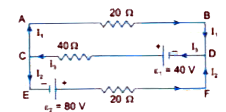State Kirchhoff's rules of current distribution in an electrical network. Using these rules determine the value of the current I1 in the electric circuit of Fig.

Text Solution
The circuit diagram can be redrawn as shown in Fig.

Here I3=I1+I2
In mesh CABDA, we have
−40.I3−20.I1+40=0
−40(I1+I2)−20I1+40=0
⇒60I1+40I2=40 ....(ii)
and in mesh EABFE, we have
−20.I1+20I2+80=0
⇒20I1−20I2=80 ....(iii)
Multiplying (iii) by 2 and then adding with (ii), we get
100I1=−120
⇒I1=−1.2A
The -ve sign shows that the direction of current is opposite to that shown in figure with an arrow mark.
|
Topper's Solved these Questions
- CURRENT ELECTRICITY BOOK - U-LIKE SERIESCHAPTER - CURRENT ELECTRICITY EXERCISE - LONG ANSWER QUESTIONS - II
8 Videos
- CURRENT ELECTRICITY BOOK - U-LIKE SERIESCHAPTER - CURRENT ELECTRICITY EXERCISE - SELF ASSESSMENT TEST (SECTION A (MULTIPLE CHOICE QUESTIONS))
6 Videos
- CURRENT ELECTRICITY BOOK - U-LIKE SERIESCHAPTER - CURRENT ELECTRICITY EXERCISE - SHORT ANSWER QUESTIONS
42 Videos
- CBSE SAMPLE QUESTION PAPER 2019-20 (SOLVED)BOOK - U-LIKE SERIESCHAPTER - CBSE SAMPLE QUESTION PAPER 2019-20 (SOLVED)EXERCISE - SECTION D
6 Videos
- DUAL NATURE OF RADIATION AND MATTERBOOK - U-LIKE SERIESCHAPTER - DUAL NATURE OF RADIATION AND MATTEREXERCISE - SELF ASSESSMENT TEST SECTION-C (VERY SHORT ANSWER QUESTIONS)
3 Videos
Similar Questions
Knowledge Check
Device used to control the current in an electric circuit is
AtransformerBvoltmeterCrheostatDgalvanometerDevice used to regulate the current in an electric circuit is
AtransformerBvoltmeterCrheostatDgalvanometer
The electric current I in the circuit shown isA6AB2AC3AD4A
State the Kirchhoff's rules used in electric networks. How are these rules justified ?
View Solution
The figure shows current in a part of electrical network. What is the value of current I?
View SolutionCurrent used in domestic electric circuits at home
View SolutionCurrent used in domestic electric circuits at home
View SolutionWhat is the value of the current I in the following part of an electrical network ?

View Solution


